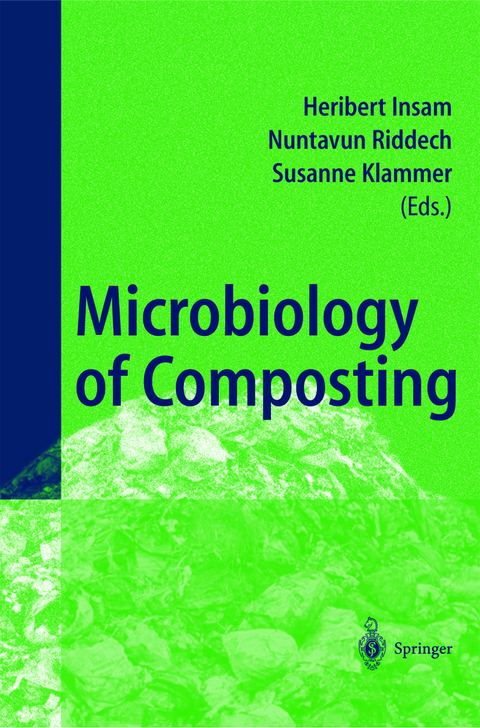
Microbiology of Composting
Springer Berlin (Verlag)
978-3-540-67568-6 (ISBN)
Microbial Communities.- How Resilient Are Microbial Communities to Temperature Changes During Composting?.- Survey of Fungal Diversity in Mushroom Compost Using Sequences of PCR-Amplified Genes Encoding 18S Ribosomal RNA.- Bacterial Community Structure During Yard Trimmings Composting.- Characterisation of Microbial Communities During Composting of Organic Wastes.- Microbial Succession During Composting of Source-Separated Urban Organic Household Waste Under Different Initial Temperature Conditions.- Bacterial Diversity in Livestock Manure Composts as Characterized by Terminal Restriction Fragment Length Polymorphisms (T-RLFP) of PCR-amplified 16S rRNA Gene Sequences.- Amplified 16S Ribosomal DNA Restriction Analysis of Microbial Community Structure During Rapid Degradation of a Biopolymer, PHA, by Composting.- Comparative Investigation of Vermicompost Microbial Communities.- Processes and Controls.- Heat Production During Thermophilic Decomposition of Municipal Wastes in the Dano-System Composting Plant.- Composting of Different Horticultural Wastes: Effect of Fungal Inoculation.- Backyard Composting: General Considerations and a Case Study.- N-Dynamics During Composting - Overview and Experimental Results.- Unsuitability of Anaerobic Compost from Solid Substrate Anaerobic Digestion as a Soil Amendment.- Pile Composting of Two-phase Centrifuged Olive Husks: Bioindicators of the Process.- Organic Acids as a Decisive Limitation to Process Dynamics During Composting of Organic Matter.- Effects of Interrupted Air Supply on the Composting Process - Composition of Volatile Organic Acids.- Reduction of Ammonia Emission and Waste Gas Volume by Composting at Low Oxygen Pressure.- Review of Compost Process-Control for Product Function.- Using Agricultural Wastes forTricholoma crassum (Berk.) Sacc. Production.- Microbial Transformation of Nitrogen During Composting.- Effect of Additives on the Nitrification-Denitrification Activities During Composting of Chicken Manure.- Biodegradability.- Biodegradability Study on Films for Packaging Based on Isotactic Polypropylene Modified with Natural Terpene Resins.- Isolation and Characterization of Thermophilic Microorganisms Able to Grow on Cellulose Acetate.- PCB's Biotransformation by a White-Rot Fungus Under Composting and Liquid Culture Conditions.- Tests on Composting of Degradable Polyethylene in Respect to the Quality of the End-Product Compost.- Microbial Degradation of Sulfonylurea Herbicides:Chlorsulfuron and Metsulfuron-Methyl.- Maturity Testing.- Hydrogen Peroxide Effects on Composting and Its Use in Assessing the Degree of Maturity.- Plant Performance in Relation to Oxygen Depletion, CO2-Rate and Volatile Organic Acids in Container Media Composts of Varying Maturity.- Microbiological and Chemical Characterisation of Composts at Different Levels of Maturity, with Evaluation of Phytotoxicity and Enzymatic Activities.- Monitoring of a Composting Process: Thermal Stability of Raw Materials and Products.- Compost Maturity - Problems Associated with Testing.- Use of CLPP for Evaluating the Role of Different Organic Materials in Composting.- Evaluation of Organic Matter Stability During the Composting Process of Agroindustrial Wastes.- Characterization of Organic Substances in Stabilized Composts of Rest Wastes.- Application and Environmental Impact.- Composting of Posidonia oceanica and Its Use in Agriculture.- Practical Use of Quality Compost for Plant Health and Vitality Improvement.- Environmental Impacts of Cattle Manure Composting.- Agronomic Value and Environmental Impactsof Urban Composts Used in Agriculture.- Composting in the Framework of the EU Landfill Directive.- Occurence of Aspergillus fumigatus in a Compost Polluted with Heavy Metals.- Important Aspects of Biowaste Collection and Composting in Nigeria.- Plant and Human Pathogens.- Use of Actinobacteria in Composting of Sheep Litter.- Methods for Health Risk Assessment by Clostridium botulinum in Biocompost.- The Fate of Plant Pathogens and Seeds During Backyard Composting of Vegetable, Fruit and Garden Waste.- Survival of Phytopathogen Viruses During Semipilot-Scale Composting.- Air-Borne Emissions and Their Control.- Composting Conditions Preventing the Development of Odorous Compounds.- Odour Emissions During Yard Waste Composting: Effect of Turning Frequency.- Imission of Microorganisms from Composting Facilities.- Molecular Identification of Airborne Microorganisms from Composting Facilities.- Bioaerosols and Public Health.- Passively Aerated Composting of Straw-Rich Organic Pig Manure.
| Erscheint lt. Verlag | 14.5.2002 |
|---|---|
| Zusatzinfo | XII, 636 p. |
| Verlagsort | Berlin |
| Sprache | englisch |
| Maße | 155 x 235 mm |
| Gewicht | 1055 g |
| Themenwelt | Naturwissenschaften ► Biologie ► Mikrobiologie / Immunologie |
| Schlagworte | Abfall • Angewandte Mikrobiologie • applied microbiology • Bioabfall • biodegradation • biowaste • composting • Hardcover, Softcover / Biologie/Mikrobiologie • HC/Biologie/Allgemeines, Lexika • Klärschlamm • Kompost • Kompostierung • Microbiology • Microorganism • Mikrobiologie • Recycling • sewage sludge |
| ISBN-10 | 3-540-67568-X / 354067568X |
| ISBN-13 | 978-3-540-67568-6 / 9783540675686 |
| Zustand | Neuware |
| Haben Sie eine Frage zum Produkt? |
aus dem Bereich


